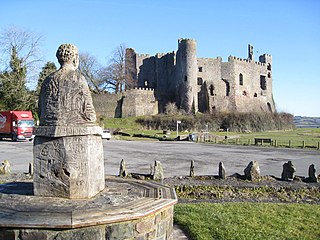Related Research Articles

Pembroke Castle is a medieval castle in the centre of Pembroke, Pembrokeshire in Wales. The castle was the original family seat of the Earldom of Pembroke. A Grade I listed building since 1951, it underwent major restoration during the early 20th century.

The Second English Civil War took place between February and August 1648 in England and Wales. It forms part of the series of conflicts known collectively as the 1639–1653 Wars of the Three Kingdoms, which include the 1641–1653 Irish Confederate Wars, the 1639–1640 Bishops' Wars, and the 1649–1653 Cromwellian conquest of Ireland.

Colonel Thomas Horton, January 1603 to October 1649, was a member of the minor gentry from Leicestershire who served in the Parliamentarian army during the Wars of the Three Kingdoms. Like many other of those who approved the Execution of Charles I in January 1649, Horton was a religious Independent. His family was closely connected to Sir Arthur Haselrig, one of the Five Members whose attempted arrest by Charles I in January 1642 was a major step on the road to the First English Civil War.

The Battle of St Fagans took place near the village of St Fagans in South Glamorgan on 8 May 1648 during the Second English Civil War. A detachment from the New Model Army defeated a Royalist force largely composed of mutinous former Parliamentarian soldiers. Victory largely ended significant Royalist resistance in Wales.

The siege of Pembroke took place in 1648 during the Second English Civil War. In the engagement, Parliamentarian troops led by Oliver Cromwell sieged Pembroke Castle in Wales. The Castle had become a refuge for rebellious Parliamentarian soldiers after the end of the First English Civil War.

Laugharne Castle is in Laugharne, Carmarthenshire, Wales. The castle, located on the estuary of the River Tâf, was originally established in 1116. It was rebuilt as a Norman stronghold. There have been many alterations since then, including becoming a Tudor fortified manor house in the sixteenth century. It changed hands twice during the English Civil War, being eventually captured by Parliamentary forces in 1644.

Major General Rowland Laugharne was a member of the Welsh gentry, and a prominent soldier during the Wars of the Three Kingdoms, in which he fought on both sides.

Montgomery Castle is a stone-built castle looking over the town of Montgomery in Powys, Mid Wales. It is one of many Norman castles on the border between Wales and England.

Richard Vaughan, 2nd Earl of Carbery KB, PC, styled The Honourable from 1621 until 1628 and then Lord Vaughan until 1634, was a Welsh soldier, peer and politician.
Events from the year 1648 in England. The Second English Civil War begins.
This article is about the particular significance of the century 1601–1700 to Wales and its people.

Holt Castle was a medieval castle in the village of Holt, Wrexham County Borough, Wales. Work began in the 13th century during the Welsh Wars, the castle was sited on the Welsh–English border by the banks of the River Dee.
Rice Powell was a Welsh Colonel in the Parliamentary army during the First English Civil War. In the Second English Civil War he allied himself with the Royalist cause. He fought in South Wales and played a significant part in events between 1642 and 1649 including a senior role during the Battle of St. Fagans.
Early in the First English Civil War the Long Parliament threatened to retaliate in kind if the Royalists tried and executed John Lilburne and two other Parliamentary offices for treason. Lilburne later described this as the declaration of Lex Talionis, and it brought about a practical—rather than moral—mutual restraint by the parties to the war on how they treated prisoners of war.

Richard Herbert, 2nd Baron Herbert of Chirbury was an Anglo-Welsh Member of Parliament, a Royalist who fought with the rank of colonel in the English Civil War, and a peer whose membership of the House of Lords was curtailed by its abolition in 1649.
Sir Hugh Owen, 1st Baronet was a Welsh politician who sat in the House of Commons variously between 1626 and 1660. He sided originally with the Parliamentarian side in the English Civil War, but the strength of his allegiance was in doubt.
Arthur Owen was a Welsh politician who sat in the House of Commons at various times between 1645 and 1678. He fought in the Parliamentary army in the English Civil War.
William Philipps was a Welsh politician who sat in the House of Commons in 1660.

Sir John Owen of Clenennau (1600–1666), was a Welsh landowner from Anglesey, who served with the Royalist army in the Wars of the Three Kingdoms, during which he held various commands in North Wales.

The Battle of Y Dalar Hir took place on 5 June 1648 in Caernarfonshire, North Wales, during the Second English Civil War. While little more than a skirmish, it had a significant effect on the local progress of the conflict.
References
- 1 2 James Frederick Rees. "Poyer, John (died 1649), mayor of Pembroke". Dictionary of Welsh Biography . National Library of Wales . Retrieved 17 March 2021.
- ↑ Willard Connely (1955). Beau Nash: Monarch of Bath and Tunbridge Wells. Laurie. p. 2. ISBN 978-7-270-01055-7.
- ↑ Brian John (1991). Pembrokeshire Folk Tales. Greencroft. p. 32. ISBN 978-0-905559-59-9.
- ↑ Calendar of State Papers, Preserved in the State Paper Department of Her Majesty's Public Record Office: Domestic series. Longman. 1891. p. 587.
- ↑ Calendar of Treasury Books, ... Preserved in the Public Record Office. H.M. Stationery Office. 1904.